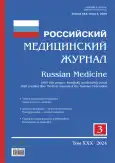Comprehensive assessment of the accuracy of heart rate determination with the personal wearable device
- Authors: Tikhomirov L.I.1, Vasil’ev L.M.1,2, Tachkin D.V.1, Khovaeva Y.B.3, Prokopenko T.I.1, Moiseenko N.P.3, Ermachkova L.V.3, Kirillov A.O.1
-
Affiliations:
- OOO “IT Professional Solutions LLC”
- Bauman Moscow State Technical University
- E.A. Vagner Perm State Medical University
- Issue: Vol 30, No 3 (2024)
- Pages: 238-248
- Section: Original Research Articles
- URL: https://journals.rcsi.science/0869-2106/article/view/262448
- DOI: https://doi.org/10.17816/medjrf629434
- ID: 262448
Cite item
Abstract
BACKGROUND: Increased resting heart rate (HR) is an independent risk factor for overall mortality, sudden cardiac death, and death from cardiovascular diseases (CVD) and a worsening factor for CVD patients’ prognosis. Moreover, HR is easy to measure and monitor independently using various devices. The accuracy of personal wearable devices used in assessing HR should be investigated.
AIM: To evaluate the accuracy of HR determination with the personal wearable device (PWD).
MATERIALS AND METHODS: An open, observational, single-center study was performed. Participants underwent physical examination, electrocardiography, HR recording using PWD, and electrocardiography Holter monitoring (HMECG). For each participant, the study duration was 14 days. The reliability of HR measured in everyday life was assessed using the PWD in comparison with HMECG as the “gold” standard. For statistical analysis, Microsoft Excel 2016 and STATISTICA 10.0 software were used. To assess the reliability of HR measured in everyday life using PWD in relation to HMECG, the hypothesis of the equality of average HR values measured by both methods was tested, a correlation analysis of time series of HR values was conducted, and Bland–Altman plots were used to visualize differences in HR values.
RESULTS: The study involved 45 healthy individuals (22 men, 49.24±6.47 years). HR data were obtained over a 24-hour period, including the subjects' routine working day. The results demonstrated good convergence between data on HR using PWD and HMECG. The relative error in determining the HR of PWD did not exceed 3.2%. The smallest relative error was recorded at night and early morning hours (0.3÷1.1%). During the daytime it was slightly higher — from 2.0 to 3.2%. A significantly high positive correlation was obtained between HR recorded using both devices, both at night (MCorrP from 0.75 to 0.85; p <0.001) and during daytime (MCorrP from 0.77 to 0.85; p <0.001).
CONCLUSION: The accuracy comparison of 24-hour HR measurements by PWD showed that they were mostly within the acceptable error range (less than 3.2%). Future studies should include HR PWD assessment in patients with various diseases.
Keywords
Full Text
##article.viewOnOriginalSite##About the authors
Leonid I. Tikhomirov
OOO “IT Professional Solutions LLC”
Email: yualeksandrova@itps-russia.ru
ORCID iD: 0009-0004-8384-2891
SPIN-code: 6212-9830
Cand. Sci. (Engineering)
Russian Federation, PermLeonid M. Vasil’ev
OOO “IT Professional Solutions LLC”; Bauman Moscow State Technical University
Email: vlmprm@yandex.ru
ORCID iD: 0009-0000-0436-1573
Cand. Sci. (Engineering), associate professor
Russian Federation, Perm; MoscowDmitrii V. Tachkin
OOO “IT Professional Solutions LLC”
Email: dtachkin@itps-russia.ru
ORCID iD: 0009-0000-7801-2501
SPIN-code: 7236-9712
Russian Federation, Perm
Yaroslava B. Khovaeva
E.A. Vagner Perm State Medical University
Author for correspondence.
Email: yaroslavakh@rambler.ru
ORCID iD: 0000-0003-1186-3867
SPIN-code: 2796-2322
MD, Dr. Sci. (Medicine), professor
Russian Federation, PermTatiana I. Prokopenko
OOO “IT Professional Solutions LLC”
Email: Prokopenko-ti@rambler.ru
ORCID iD: 0009-0006-0038-1466
SPIN-code: 5170-1868
Russian Federation, Perm
Natalja P. Moiseenko
E.A. Vagner Perm State Medical University
Email: nataliamoiseenko@mail.ru
ORCID iD: 0000-0002-9836-9548
SPIN-code: 7525-1014
MD, Cand. Sci. (Medicine)
Russian Federation, PermLarisa V. Ermachkova
E.A. Vagner Perm State Medical University
Email: lermachkova.2017@mail.ru
ORCID iD: 0000-0001-8792-6065
SPIN-code: 7445-2344
MD, Cand. Sci. (Medicine), associate professor
Russian Federation, PermArtem O. Kirillov
OOO “IT Professional Solutions LLC”
Email: akirillov@itps-russia.ru
ORCID iD: 0009-0001-4174-8387
Russian Federation, Perm
References
- Shalnova SA, Deev DA, Belova OA, et al. Heart rate and its associations with the main risk factors in a population of men and women of working age. Rational Pharmacotherapy in Cardiology. 2017;13(6):819–826. EDN: YLLVBD doi: 10.20996/1819-6446-2017-13-6-819-826
- Revishvili AS, Popov VA, Korostelev AN, et al. Predictors of the development of atrial fibrillation after coronary artery bypass surgery. Journal of Arrhythmology. 2018;(94):11–16. EDN: VNFTHO doi: 10.25760/VA-2018-94-11-16
- Jensen MT. Resting heart rate and relation to disease and longevity: past, present and future. Scand J Clin Lab Invest. 2019; 79(1-2):108–116. doi: 10.1080/00365513.2019.1566567
- Custodis F, Roggenbuck U, Lehmann N, et al. Resting heart rate is an independent predictor of all-cause mortality in the middle aged general population. Clin Res Cardiol. 2016;105(7):601–612. doi: 10.1007/s00392-015-0956-7
- Lindgren M, Robertson J, Adiels M, et al. Resting heart rate in late adolescence and long term risk of cardiovascular disease in Swedish men. Int J Cardiol. 2018;259:109–115. doi: 10.1016/j.ijcard.2018.01.110
- Al-Khatib SM, Arshad A, Balk EM, et al. Risk stratification for arrhythmic events in patients with asymptomatic pre-excitation: a systematic review for the 2015 ACC/AHA/HRS guideline for the management of adult patients with supraventricular tachycardia: a report of the American College of Cardiology/American Heart Association Task Force on Clinical Practice Guidelines and the Heart Rhythm Society. J Am Coll Cardiol. 2016;67(13):1624–1638. doi: 10.1016/j.jacc.2015.09.018
- Shcherbina A, Mattsson CM, Waggott D, et al. Accuracy in wrist-worn, sensor-based measurements of heart rate and energy expenditure in a diverse cohort. J Pers Med. 2017;7(2):3. doi: 10.3390/jpm7020003
- Støve MP, Hansen ECK. Accuracy of the Apple Watch Series 6 and the Whoop Band 3.0 for assessing heart rate during resistance exercises. J Sports Sci. 2022;40(23):2639–2644. doi: 10.1080/02640414.2023.2180160
- Hajj-Boutros G, Landry-Duval MA, Comtois AS, et al. Wrist-worn devices for the measurement of heart rate and energy expenditure: a validation study for the Apple Watch 6, Polar Vantage V and Fitbit Sense. European Journal of Sport Science. 2023;23(2):165–177. doi: 10.1080/17461391.2021.2023656
- Wallen MP, Gomersall SR, Keating SE, et al. Accuracy of heart rate watches: implications for weight management. PLoS One. 2016;11(5):e0154420. doi: 10.1371/journal.pone.0154420
- Thakur S, Chao PCP, Tsai CH. Precision heart rate estimation using a PPG sensor patch equipped with new algorithms of pre-quality checking and hankel decomposition. Sensors. 2023;23(13). doi: 10.3390/s23136180
- Sarhaddi F, Kazemi K, Azimi I, et al. A comprehensive accuracy assessment of Samsung smartwatch heart rate and heart rate variability. PLoS One. 2022;17(12):e0268361. doi: 10.1371/journal.pone.0268361
Supplementary files







